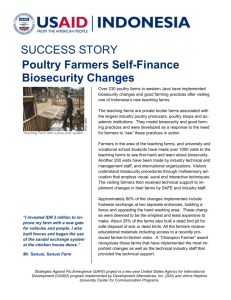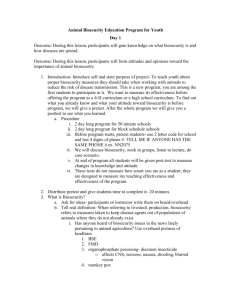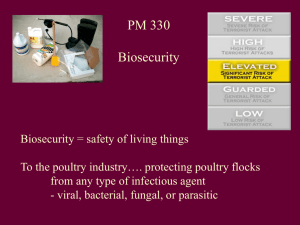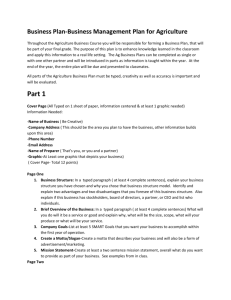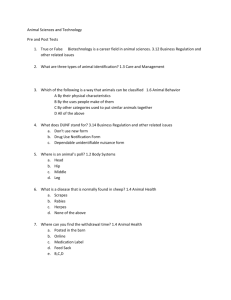COMMERCIAL EGG TIP . . . Cooperative Extension Service
advertisement
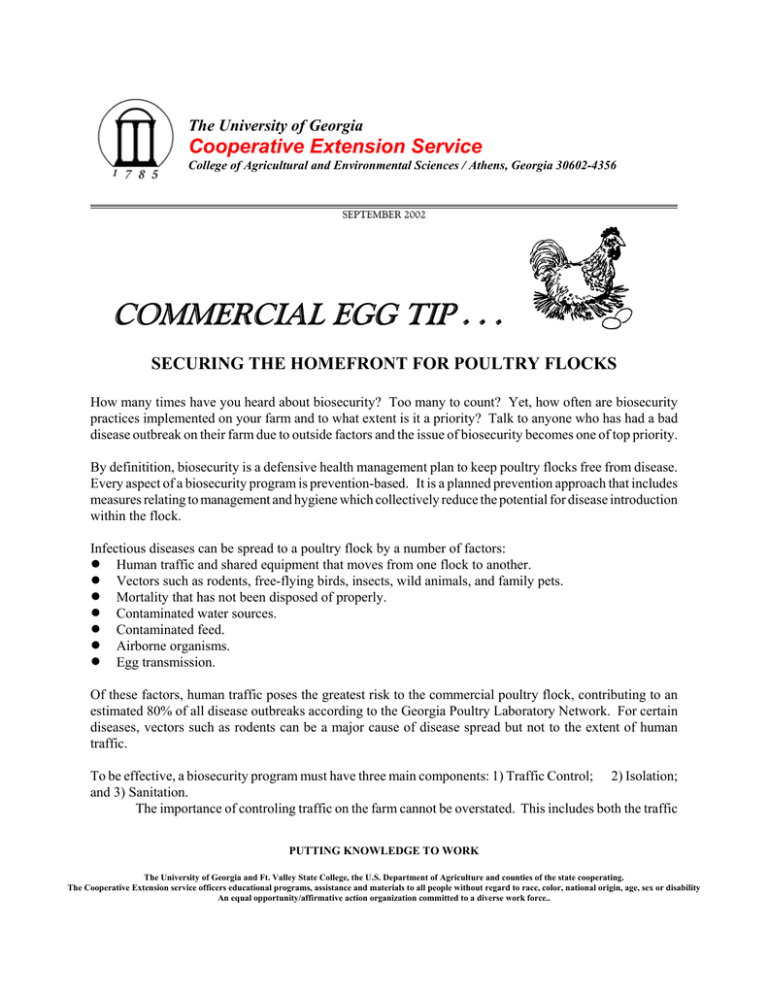
The University of Georgia Cooperative Extension Service College of Agricultural and Environmental Sciences / Athens, Georgia 30602-4356 SEPTEMBER 2002 COMMERCIAL EGG TIP . . . SECURING THE HOMEFRONT FOR POULTRY FLOCKS How many times have you heard about biosecurity? Too many to count? Yet, how often are biosecurity practices implemented on your farm and to what extent is it a priority? Talk to anyone who has had a bad disease outbreak on their farm due to outside factors and the issue of biosecurity becomes one of top priority. By definitition, biosecurity is a defensive health management plan to keep poultry flocks free from disease. Every aspect of a biosecurity program is prevention-based. It is a planned prevention approach that includes measures relating to management and hygiene which collectively reduce the potential for disease introduction within the flock. Infectious diseases can be spread to a poultry flock by a number of factors: ! Human traffic and shared equipment that moves from one flock to another. ! Vectors such as rodents, free-flying birds, insects, wild animals, and family pets. ! Mortality that has not been disposed of properly. ! Contaminated water sources. ! Contaminated feed. ! Airborne organisms. ! Egg transmission. Of these factors, human traffic poses the greatest risk to the commercial poultry flock, contributing to an estimated 80% of all disease outbreaks according to the Georgia Poultry Laboratory Network. For certain diseases, vectors such as rodents can be a major cause of disease spread but not to the extent of human traffic. To be effective, a biosecurity program must have three main components: 1) Traffic Control; 2) Isolation; and 3) Sanitation. The importance of controling traffic on the farm cannot be overstated. This includes both the traffic PUTTING KNOWLEDGE TO WORK The University of Georgia and Ft. Valley State College, the U.S. Department of Agriculture and counties of the state cooperating. The Cooperative Extension service officers educational programs, assistance and materials to all people without regard to race, color, national origin, age, sex or disability An equal opportunity/affirmative action organization committed to a diverse work force.. onto the farm and on-farm traffic patterns. Vehicles and equipment that must visit more than one farm should be carefully washed and disinfected before leaving one farm and entering the next. Discourage the loaning of equipment such as litter spreaders from one farm to another. Avoid visiting other poultry farms, particularly those that grow a different bird type. If practical, keep a logbook of all visitors in order to trace a disease’s path should an outbreak occur. When visitors do arrive, direct the flow of human traffic from youngest birds to older birds if more than one age is on a farm. Footwear should be disinfected to and from each site and between buildings to help decrease the spread of organisms carried from one location to the next. If footbaths are used as a means of disinfection, they must be located where they are unavoidable and will get the most use, such as directly in a doorway. A nice and clean footbath in the corner with a lid over it will accomplish nothing if it does not get used. Isolating your flock from the outside world within a controlled environment is not always an easy thing to do, but keeping your birds confined not only keeps them protected from the elements but helps to keep other animals and organisms out. Isolation includes a pest control program for vector intruders that focuses on eliminating possible access points to keep pests from finding a suitable living habitat within or adjacent to the poultry facilities. Isolating poultry from other livestock is also important as chickens, turkeys, cattle, swine and equine are all subject to cross infection. In addition, farm employees should not be allowed to own backyard poultry, exotics or pet birds. Sanitation encompasses the cleaning and disinfection of materials and equipment entering the farm and the cleanliness of existing facilities and personnel. All-in/all-out management allows for the depopulation of facilities between flocks and the sanitation and disinfection of housing and equipment to break the cycle of disease. Biosecurity practices are teamed up with sanitation and disinfection procedures to reduce pathogens to non-infectious levels. A sanitized, vacant house becomes free of pathogens more rapidly than a house that is left to stand dirty. Proper disposal of mortality and loose trash is a critical control point for good sanitation and effective vector control. If having a good biosecurity program is so important, why then don't more people make the effort to put a program in place? Is it because of economics, convenience, or perhaps a little of both? Poultry growers will often underestimate the real cost of disease. Besides outright mortality, loss of live weight or egg production and cost of feed prior to death are contributors to lost revenue. Morbidity in those birds that remain alive can also have an impact through poorer weight gains, higher feed conversion and increased condemnations at the processing plant. And of course there can be the additional costs of disease diagnosis, vaccinations and medications. A biosecurity program must be practical and flexible in nature to increase the likelihood that it will be followed. In order to judge how much biosecurity is practical, economics, common sense, and relative risk must be weighed together to determine to what extent a biosecurity program is implemented. When it comes down to it, a biosecurity program is a low-cost disease "insurance" policy. Biosecurity is the cheapest, most effective means of disease control and in reality is only an added cost until there is a disease problem. Then the cost of disease recovery far outweighs the cost of disease prevention. View biosecurity expenditures not as unnecessary costs but as investments in a productive and profitable future. Make biosecurity disease prevention the only disease connection on your farm. References Biosecurity for Exotic Fowl, by J.S.D. Jeffrey, Texas A&M University Casey W. Ritz Extension Poultry Scientist Extension Poultry Coordinator/Agent **Consult with your poultry company representative before making management changes.**

